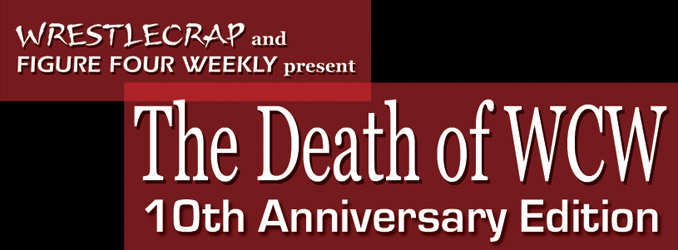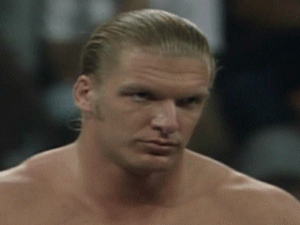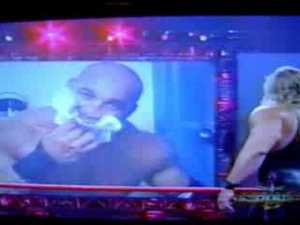Next month will mark exactly ten years since I first stepped into a pro wrestling ring as a worker. In the last ten years, I have learned so very much about the business, and yet every single day I learn something new. The business has been extremely good to me, so good that I feel like I will never truly pay my dues. But that’s okay, I would much rather always feel like I’m giving back to wrestling than I would want to feel like I’m taking from it. 2014 will be a pivotal anniversary for me and wrestling, and it also marks a unique anniversary for something else wrestling-related that I absolutely love.
Ten years ago, “The Death of WCW,” my #1 favorite wrestling book of all time, was released. Written by Bryan Alvarez & R.D. Reynolds, this tome is a historical re-telling of how WCW became the number-one professional wrestling promotion in the world, and how it died an extremely painful death shortly thereafter. This year they released a special tenth anniversary edition, which is updated with corrections to come of their statistics in the previous book, and updated with all-new information left out the first time around. They’ve also added a significant amount of “lesson not learned” snippets, detailing how promotions like WWE and TNA have repeated the drastic and costly mistakes made by WCW over a decade ago. The tenth anniversary book also has all new photos. In fact, I believe 100% of the photos included this time around were not in the original, and vice versa. It is a must read for anyone who likes wrestling, especially fans who were watching during that time period, and any and all workers who’ve been fortunate enough to become a part of this business I love.
To celebrate the anniversary, I’ve taken my old copy of the book (that would be the first one) and cut out my favorite snippets for you to enjoy. I’m using the old pages for this because I don’t want to give out anything from the new book. To be fair though, most of what I’m putting in this blog is still included, in some cases word-for-word, in the new edition, so I’m not giving anything away. If nothing else, it should encourage you to pick up this book and check it out yourself.
Still on the fence? Well, check out these direct quotes and maybe they’ll change your mind.
1. “The de-emphasis of the Cruiserweight division led to a lot of bad blood between [Brian] Pillman and [Bill] Watts, which escalated when Watts told Pillman he was looking to cut his pay. Pillman, who was under contract, told Watts to shove it. Watts responded by stating that he would job out Pillman (make him lose all his matches) for the remainder of his tenure. “Fine,” Pillman replied. “I’ll be the world’s highest-paid jobber.””
The early 90’s had quite a bit of a power-struggle between various bookers, and one of the least popular was the old UWF promoter, the legendary “Cowboy” Bill Watts, who made a lot of bad decisions that severely pissed off those working for him. One of them was banning moves off the top rope, shortly after the incredible Pillman-Jushin Lyger match from the 1992 Superbrawl PPV. Watts made some other decisions that not even your own boss would be foolish enough to make – check out the book to find out what!
2. “Anyone involved in wrestling – especially promoters and bookers – should take note that even when things appear to be taking off, nothing happens overnight. All the angles that WCW booked in mid-1996 certainly increased casual fan interest in the product. This interest, however, did not immediately turn the company’s fortunes around. In fact, despite all the awesome hype leading up to Bash at the Beach, the show actually did fewer buys than the PPV the year prior (0.71 versus 0.82). Nitro ratings were up, but that was slightly deceptive, partially owing to the addition of an unopposed first hour. And house show attendance, legitimately up a whopping 125 percent, was the result of the [Ric] Flair versus [Randy] Savage feud that started earlier in the year, and had nothing to do with the nWo.”
An important lesson that, as incredible as the New World Order was, it didn’t make immediate changes to WCW’s success. This was also the year that Nitro became a two-hour show (Scott Hall debuted on that first two-hour broadcast) and proof positive that even your hottest angle isn’t the end-all be-all of the show. This is a lesson that was never learned in WCW…and in some cases, still hasn’t been learned. Bash at the Beach ’96, for those who don’t know, is when Hulk Hogan turned heel and joined the nWo.
3. “In addition to Goldberg, WCW also had another star tailor-made for success, ironically as the result of an in-ring tragedy: Buff Bagwell, who had been injured earlier in the year taking a top rope bulldog. The injury was so bad that when it happened, everyone broke character and rushed to his aid. Doctors later told Buff that he was just three inches away from that worst-case scenario, and that he’d nearly died twice due to complications. After undergoing double fusion neck surgery the next day, in a near miracle, he was told that he’d probably be able to return to training within six months. In his return to Nitro, Bagwell came out in a wheelchair for a face-to-face meeting with the man who broke his neck, Rick Steiner. He told Rick that it was an accident and forgave him for what happened. The people cheered. The other half of the former Steiner Brothers tag team, the heel Scott, then came out and hit his brother with a chair. Bagwell stood up, apparently to the make the save, but then jumped Rick and tore his shirt off to reveal, that’s right, “nWo.” In that instant, not only was the next potentially huge babyface star flushed down the drain, but a real-life neck injury was turned into a cornball wrestling angle. What should have been a new birth for Bagwell’s major-league career ended up being the beginning of its end.”
One of my favorite pieces from the book, because of how incredible it is. Anyone reading this, whether you’re an insider or just a fan, can see what a horrible mistake this was. Where is Buff Bagwell now? In the hall of fame? Nope, he’s a male escort. His career could have meant so much more, but it was destroyed in one segment. This is especially sad because hardcore fans hated Bagwell up to that point, and this was his best chance to win them back. This also happened in early 1998, the time when the New World Order was stale as hell, and when one moment in the WWF turned around their fortunes, forever (it’s explained in the very next paragraph in the book too).
4. “Among those who argued against bringing Ric Flair back to the WWF was a young man by the name of Hunter Hearst Helmsley, who said outright in a radio interview that Flair should just retire. This was the same Triple H who, five years later, would end up best buddies with the still-active Flair on WWE television, and would, in fact, write the forward to Flair’s autobiography.”
Amazing how much can change in five years, huh? The book illustrates how many people hated Flair behind the scenes, and did everything they could to humiliate him, despite the fact that was WCW’s biggest draw historically. Ego is the name of the game here.
5. “Other changes were made to the give the shows a more “entertainment” feel. For instance, Stevie Ray had suddenly and mysteriously become a major part of Nitro (despite the fact that he wasn’t a great worker by any stretch of the imagination). Not only was he given inordinate amounts of time in the ring, but he was given tons of interview time. His promos were, well, interesting. He once identified Barbarian and Meng as “two fish-eating chumps from Gilligan’s Island.” Later, he would call Scott Steiner both “synthetic” (seemingly an accusation of steroid use) and also a “sad, sack-ass fruit booty” (seemingly an accusation of … well we have no idea.”
In order to keep up with Raw’s rising popularity, Eric Bischoff ordered the show to be more like Raw with more vignettes and skits. Stevie Ray was part of that master plan, and you see how well that worked out.
6. “One man who managed to get out of WCW before it all hit the fan was Paul Wight, a.k.a the Giant, who made his WWF debut at the St. Valentine’s Day Massacre PPV from Memphis on February 14. He came out from under the ring, interfering in a Vince McMahon versus Steve Austin cage match and accidently assisting Austin’s win. The WWF, having had so much success with Andre the Giant, had always had an eye on Wight. McMahon repeatedly ridiculed Wight’s WCW run, saying the idiots there had no idea how to book a man as a giant. He then proceeded to spend several years booking Wight (who took on the ring name Big Show) a million times worse than WCW had done on their most inept day. In fact, just weeks after his debut, he was presented as just another big doofus doing a clean pinfall job to Austin.”
No matter what happened in WCW, the simple fact is that they did some things better than the WWF. It’s funny how many of my friends, who are Big Show fans, have given me crap for never being behind his character. The answer is quite simple: look at how WCW booked him, versus how the WWF did. Simply put, with so many character changes, alignment switches, and convoluted booking, the only thing the WWE ever did with him that I truly enjoyed was tag him with Chris Jericho. Sorry Show fans, just calling it like I see it.
7. “”I remember one time Goldberg met Mark McGwire, who was on the verge of breaking the home run record and was in the news literally every day,” recalls Bobby Heenan. “McGwire was a huge mark for wrestling. He and Goldberg met up before a game, did some batting practice. Had this happened in the WWF, they’d have filmed everything, probably had Goldberg and McGwire going to Louisville to pick out bats. But we never showed anything. We weren’t allowed to make mention of it, because it wasn’t WCW’s idea.””
The book of great quotes from several workers who were there during WCW’s downfall, one of them being color commentator Bobby Heenan, who truly hated working there. This quote is a response to how WCW wouldn’t do anything they didn’t make mention of, but fortunately, how they also avoided mentioning a Jay Leno spot that would have made them look like morons.
8. “Following the airing of an ESPN Outside the Lines special that touched on steroid and human growth hormone use in pro wrestling, WCW scheduled a “surprise drug test” before the April 15 Thunder. Strangely, Scott Steiner no-showed the event, claiming he had suffered a back injury, and was therefore not tested. Not only has Steiner become so muscular he could barely move, he had also developed a short temper, seemingly flying into an uncontrollable rage at the slightest provocation, to the point that he had been arrested several times. In a match the following week on Nitro (his back seemingly miraculously healed in less than a week), he carried the near-400-pound Scott Norton all the way across the ring before giving him an atomic drop. The crowd, oddly, chanted “STEROIDS!” during the match. Bobby Heenan responded by shouting, “I’ve never heard a crowd so pumped up before!””
Scott Steiner stories are gold, and there plenty of them in this book.
9. “Even with [Vince] Russo gone, the string of stupid storylines continued. One angle featured Big T, who had several years earlier been the WWF’s Ahmed Johnson, filing a lawsuit against Booker T claiming that he owned the rights to the letter T. Big T would eventually win the bout (and the letter) in a match that would have been a main event on any episode of Sesame Street worldwide.”
Want a full historical detailing of how badly Vince Russo screwed up WCW, and then what he did to TNA? You know what book to buy by now.
10. “WCW contracts were often used in Russo’s storylines, the idea frequently being that if the worker could destroy the contract, they were free to leave the company. Strangely, however, these contracts could seemingly not be destroyed. For example, one day Goldberg got mad and ate Scott Hall’s contract on TV. Yes, he ate it like it was, say, a taco. Amazingly, the next week, the contract was back on TV, looking as pristine as ever.”
Either Russo’s storylines are garbage, or Goldberg is the world’s cleanest Jew. Anyway, this is one of my favorite lines in the book and it still makes me laugh, ten years later.
So why read the Death of WCW? To see more about ridiculous Russo storylines, and how much he attempted to spin numbers in his favor, when hard numbers tell the truth. You can read about all the critical mistakes WCW made pushing the New World Order, and giving Hulk Hogan complete creative control. You can read about how the fragile backstage egos ruined Goldberg and Ric Flair, and how the “Vanilla Midgets” (Chris Benoit, Eddy Guerrero, Perry Saturn and Dean Malenko) were downplayed right out the door and the impact their debut in the WWF made. See what happened when the company put the belt on David Arquette, and how hard poor guys like Jeff Jarrett, Diamond Dallas Page, and the legendary Sting worked to save the sinking ship. And then, read what happens when WCW died, was bought by Vince McMahon, and died all over again.
This is THE best wrestling book ever written in my eyes, even better than the countless autobiographies I’ve read, and I cannot recommend this any higher than I am right now.
Do yourselves a favor and read “The Death of WCW.” Get the ten-year anniversary edition to read all the updated figures, and see how WCW’s horrible booking decisions have been COPIED by the WWE and TNA. It’s impossible to believe, but it’s true.
Read “The Death of WCW,” and realize how much potential the wrestling business truly has, and how badly we’re missing out in his day and age.












